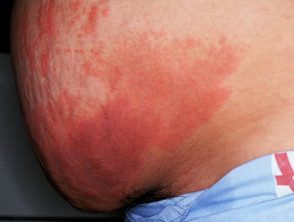What is heparin induced? thrombocytopenia?
There are two forms of heparin-induced thrombocytopenia, type 1 and type II. Type I heparin-induced thrombocytopenia is harmless, causing a mild and transient reduction in platelet count.
Heparin-induced thrombocytopenia type II (HIT) is a more serious disease autoimmune disease that causes a low platelet count and paradoxical blood clotting.
- Heparin-induced thrombocytopenia type II occurs in 1 to 5% of patients started on heparin.
- It usually occurs 5 to 10 days after starting the medication.
- It is characterized by a platelet count of <150 x 109 9/ l (or a reduction ≥ 50% in platelets), which occurs in >90% of HIT patients.
Heparin can also lead to other cutaneous reactions, including:
- Ulceration due to other causes of heparin induced necrosis.
- Injection site erythemaand eczematouspainful or itchy plates
- Generalized hypersensitivity reactions like anaphylaxis, acute urticariaand cutaneous vasculitis.
What are the clinical characteristics of heparin-induced thrombocytopenia?
Two thirds of people with heparin-induced thrombocytopenia develop a reduction in platelet count without symptoms.
However, approximately 30% of patients with heparin-induced thrombocytopenia develop thrombosis (heparin-induced thrombocytopenia with thrombosis or HITT). Thrombosis can occur in veins, arteries or small vessels in the skin, in the brain (causing stroke), in the legs (causing deep vein thrombosis), in the lungs (causingpulmonary plunger), in the heart (myocardium heart attack), or in fingers and toes (digital necrosis). Blood clots block the affected vessel causing necrosis.
Skin necrosis manifests itself as acutely demarcated tender red or purple patches (purple) that develop black centers and can cause dryness gangrene. A retiform, network-like or branching pattern of purple may also be seen. Necrosis may occur at the site of subcutaneous heparin injection or infusion, or at distant sites.
Heparin-induced thrombocytopenia

Purpura due to heparin-induced thrombocytopenia

Purpura due to heparin-induced thrombocytopenia
What causes heparin-induced thrombocytopenia?
Heparin is a widely used natural anticoagulant or “blood thinner.” It works by activating antithrombin, which in turn inactivates thrombin and prevents clots from forming.
Heparin-induced thrombocytopenia type II is due to a antibody which binds to heparin and platelet factor 4 complexes. The Fc-binding protein in the antibody complex matches the Fc receptors on platelets, activating them. Platelet aggregation and consumption continues. Platelet levels are reduced from pre-treatment levels. If platelet aggregation is severe enough, it causes the formation of a “white clot” that results in a complete blockage of the affected artery or vein. The specific symptoms depend on the organ to which the blood supply is blocked.
Antibodies Take the time to develop into autoimmune diseases. heparin-induced thrombocytopenia It usually occurs 5 to 10 days after starting treatment. Patients who develop heparin-induced thrombocytopenia within hours of starting treatment are likely to have been exposed and therefore sensitized to heparin previously.
Unfractionated heparin is more likely to cause heparin-induced thrombocytopenia than fractionated heparin (also called low molecular heparin weight).
Investigations if heparin-induced thrombocytopenia is suspected
Patients receiving heparin should have their blood count measured regularly to check platelet levels. Heparin-induced thrombocytopenia can be diagnosed if there is a reduction compared to pretreatment levels, even when the absolute platelet level is still within the normal range.
Functional tests to detect heparin-induced thrombocytopenia include:
- Heparin-induced platelet aggregation (HIPA) test
- Serotonin release assay (SRA).
Immunoassays to detect antibodies against heparin-platelet factor 4 are more sensitive but less specific compared to functional tests.
Skin biopsy of skin necrosis can help in the diagnosis. In heparin-induced thrombocytopenia, there are blocked arteries, veins, and small blood vessels without inflammation. Histology cannot distinguish white clots formed by platelet plugs from red fibrin clots
Treatment for heparin-induced thrombocytopenia
Heparin injections or infusions should be discontinued.
Alternative anticoagulation may be required to prevent life-threatening thrombosis. This usually occurs with factor Xa inhibitors, such as danaparoid, or direct thrombin inhibitors, such as bivalirudin or dabigatran.
There have been several cases of warfarin-induced skin necrosis when warfarin monotherapy has been used in patients with heparin-induced thrombocytopenia. This is thought to be because warfarin reduces the activity of protein C. Therefore, warfarin alone is not recommended in patients with active heparin-induced thrombocytopenia.
Reexposure to heparin is not recommended during the acute phase of heparin-induced thrombocytopenia and the post-acute period while circulating antibodies are still present. If heparin-induced thrombocytopenia occurred a long time before, all antibodies may have cleared and it may be safe to use heparin again. however recurrent Heparin-induced thrombocytopenia has been described in some patients.
Advice on treatment and rechallenge should be sought from a hematologist.

